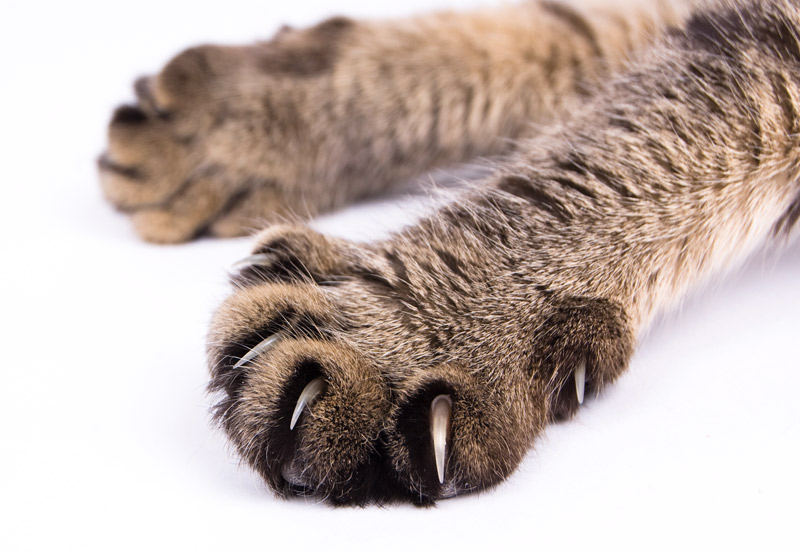The fight against the inhumane practice of declawing is slowly gaining ground, thanks to new legislation.
Many people think declawing is no big deal – it’s just like having your fingernails cut, right? Wrong! Unlike human fingernails, cats’ claws grow directly from the last bone of the toe. That means the entire bone must be removed to prevent the claw from re-growing. Each toe – bone, nerves, blood vessels, ligaments, skin and all – is severed at the first joint. Declawing is essentially amputating a third of the cat’s paws.
Not surprisingly, surgical declawing has been controversial since it was devised in the 1960s. And the debate has only grown more contentious over the years. Opponents say declawing is cruel. Defenders (mostly veterinarians) say it is not.
The surgical procedure is illegal or considered inhumane in dozens of countries around the world. Even in countries where declawing is still legal, such as New Zealand, Thailand and South Africa, it is “just not done.” In fact, the process is common only in the United States and Canada.
Here, in recent years, the long war over declawing has shifted to the legal field, at least in California. In 2003, West Hollywood passed an ordinance banning declawing within the city limits, based on animal cruelty statutes. The California Veterinary Medical Association (CVMA) responded by filing a lawsuit, alleging the new ordinance was illegal under existing California law because it infringed on the practice of a state-licensed profession. The Superior Court agreed, and the ordinance was voided. West Hollywood appealed, and the ruling was reversed by the state Court of Appeal, thereby upholding the ban. The CVMA appealed again but the California Supreme Court refused to hear the case – in effect affirming the ordinance.
But the CVMA didn’t stop there. It introduced legislation at the state level designed to stop other cities from outlawing declawing by preventing municipalities from making any laws restricting such licensed professions. While concealing the bill’s true purpose, the CVMA garnered support from other licensed professions, such as dentists and physicians. The legislation passed, was signed by the governor in July 2009, and was scheduled to take effect on January 1, 2010.
Thankfully, this delayed effective date provided a window of opportunity for declaw opponents. Led by Dr. Jennifer Conrad of The Paw Project, a non-profit organization that inspired the original West Hollywood law, ordinances to ban declawing were introduced in several cities in California.
By the end of 2009, seven cities had joined West Hollywood in making declawing illegal within their city limits: Berkeley, Beverly Hills, Burbank, Culver City, Los Angeles, San Francisco and Santa Monica. Only Malibu failed to approve it; the city later passed a resolution condemning declawing, but it has no legal effect on veterinarians performing the surgery.
The CVMA vehemently opposed each ordinance, while ban supporters passionately defended their position. Nevertheless, every city council and board of supervisors – once they truly understood what declawing was and how it affects cats – overwhelmingly (often unanimously) supported a ban. It was crystal clear to these local legislators that declawing is in fact animal cruelty, and should be prohibited.
What did these council members and supervisors see that veterinarians don’t seem to get?
- In 2006, the USDA amended the Animal Welfare Act to prohibit declawing of exotic carnivores (including big cats). It reasoned that declawing “can cause considerable pain and discomfort to the animal and may result in chronic health problems.” Domestic cats are, anatomically, small versions of big cats such as lions, jaguars and bobcats. But domestic cats are very good at concealing pain and illness; and their size can make problems less obvious.
- Medical complications from declawing are common. Scientific studies have found post-operative complications in up to 83% of cats (not surprisingly, complication rates were highest at veterinary teaching hospitals with students performing the surgeries).
- The potential for behavioral complications following declawing is the most hotly contested issue in the entire declaw debate, though perhaps the least important. Oddly, both sides use the same studies to make their points. For instance, declawing opponents cite research showing that up to 33% of cats developed a behavior problem (primarily biting or not using the litterbox) after being declawed; but declawing defenders find reasons to disbelieve or ignore that data.
Some problems, such as bleeding or lameness, occur immediately after surgery, but others (such as arthritis due to altered gait) may not be apparent for years. That time lag allows for an intellectual “disconnect” between declawing and later problems.
Very little research has been done on declawing for several years (other than on new drugs or techniques) and there has been no research on behavioral effects in the last decade. To declawing opponents, this seems like willful ignorance – a desire not to know any more about the effect of declawing on cats. It’s clear to many that the long-term consequences are severe, and many (perhaps most) declawed cats experience chronic pain. Research on phantom pain in humans, for instance, confirms that 100% of amputees have phantom sensations, 40% of which are painful. Declawed cats have had multiple separate amputations – how could they not have pain?
Unless and until adequate research is done, these questions are unlikely to be resolved. To stop declawing, animal advocates have relied on educating the public; but that’s a frustratingly slow process.
The legal arena has been more productive, not only for awareness and education, but for serious progress toward the goal of a declawing ban. This is the case even when legislation fails, as it did in Connecticut in 2008. But veterinarians are more organized and have more money available for legal fights. How will it end? We can only hope that the well being of cats will be the ultimate winner.
Humane Alternatives
“My view is that if you care more about your upholstery than your cat, then you shouldn’t have cats,” says Sheryl, who shares her home with three feline friends. “Mine sometimes scratch the furniture, but it’s a small price to pay for the joy of their companionship.”
In 95% of cases, people have their cats declawed to protect their household furnishings from scratches and snags.
- Buying a few scratching posts can do the job humanely. Place the posts in the same room as your furniture, and rub some dried catnip on them to encourage your cat to use them.
- Put some machine washable slipcovers over the furniture you want to protect.
- If all else fails, shut your cat out of the living room when you’re not around to monitor him.







No Comment